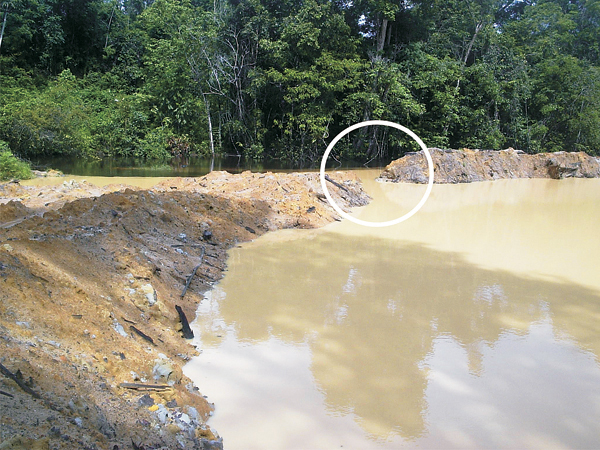By Gaulbert Sutherland
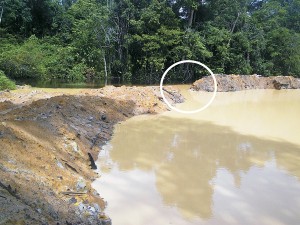 Breaches of the mining regulations were evident during a recent visit to Quartz Hill and nearby areas, resulting in pollution and fouling of waterways even as the Guyana Geology and Mines Commission (GGMC) strives to enforce the rules and advocate self-regulation.
Breaches of the mining regulations were evident during a recent visit to Quartz Hill and nearby areas, resulting in pollution and fouling of waterways even as the Guyana Geology and Mines Commission (GGMC) strives to enforce the rules and advocate self-regulation.
While human resources constraints have been cited as one probable reason for the infringements, GGMC Commissioner, William Woolford said that as increasing numbers of persons enter the gold mining industry, the commission has recruited additional staff. “The fact is we have seen the industry grow and we added more staff in response to that…we are responding to the growth”, he stated. He pointed out too that miners have a responsibility with regards the manner in which they carry out their operations and need to be self-regulating.
Prime Minister Samuel Hinds, who is the Minister responsible for Mining told a mining conference recently that industry practices that despoil the environment will no longer be tolerated. “The sector must become better because in addition to the gross effect of increased numbers, the expectations of the sector are being raised. Practices tolerated before will be tolerated no more”, he said.
The Prime Minister noted that the industry is challenged by the necessity to significantly reduce the negative environmental effects of mining and said that the increased numbers and capacity of the average miner to move dirt and despoil the environment calls for higher levels of operations aimed at reducing and mitigating these impacts. He expressed the belief that the sector can reach and even surpass reasonable targets. He said that sometimes, environmentalists present the worst instances as though they were typical and in this regard the sector needs to get together and “keep each other in line”.
 The Mining (Amendment) Regulations 2005, made under The Mining Act, No. 20 of 1989, and which was designed to ensure environmentally friendly operations, are currently being enforced by the GGMC but miners are clearly unaware of some sections.
The Mining (Amendment) Regulations 2005, made under The Mining Act, No. 20 of 1989, and which was designed to ensure environmentally friendly operations, are currently being enforced by the GGMC but miners are clearly unaware of some sections.
The rules have seen changes in the way in which mining operations are now carried out, but infractions continue. Woolford said that these needed to be looked at in a larger context, with just a fraction of the 700 operations countrywide committing violations. He said that officers try to visit each operation. “The monitoring we do is systematic”, he told this newspaper in an interview. He contended that they try to monitor each of the 700 operations twice every year. Noting that it is a process that is ongoing, he said that there would be an “environmental sweep”, whereby GGMC personnel would go to all mining areas and check on compliance.
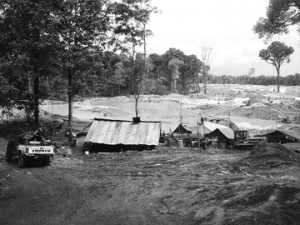 Meanwhile, unsafe use of mercury, breached tailings ponds and mining activities close to water courses were some of the infringements, this newspaper discovered on a visit to the Quartz Hill mining district at the Omai Backdam last week.
Meanwhile, unsafe use of mercury, breached tailings ponds and mining activities close to water courses were some of the infringements, this newspaper discovered on a visit to the Quartz Hill mining district at the Omai Backdam last week.
As a result of the breached tailings ponds, a section of the Omai Creek was heavily discoloured with a yellow sludge, which made its way to the Essequibo River.
GGMC has established a presence in the area, and Woolford said that two officers are stationed at different locations there. But while this newspaper was in the district, no activity was ongoing to repair the breaches though the commissioner said that the officers should have been visiting the area regularly. He added that it expected that miners would practise self-regulation. “We expect miners to show some self-regulation…the majority of them do”, he said.
Additionally, while miners in the area that this newspaper spoke with seem generally knowledgeable about their obligations under the regulations, some are opposed to them and seem to conform only to avoid being shut down by the authorities. Miners too are unaware of other aspects of the regulations, and said that these are not being insisted on.
Model
But there have been some changes and medium-scale miner, Gregory Brandon, who has spent 15 years in the industry, is among those who play their part in conforming to the regulations. Presently managing, what he described as a medium-scale gold mining operation at Block M6, close to the Granny Hill area and aware of the mining regulations, Brandon disclosed that his mine was used as a model by the GGMC for other miners in the area to emulate. His mine utilizes two dredges and an excavator and recycles water used in its operations. He explained that water used during the operations goes into a settling pond where a flocculent is used to hasten the settling of the suspended particles in the mixture. The clear water is then transferred to a reservoir to be utilized when necessary.
This mine has been in operation since last July when the regulations were being enforced and operations were stopped twice since, at the time, the mine hadn’t a tailings pond and this was required. Was it hard to conform to the requirements? “Initially, it was hard, there was no space for the kind of preparation that they (GGMC) had wanted”, Brandon said noting that as the work went on, the space for the settling pond and reservoir was created.
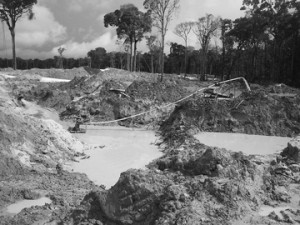 At the time that Stabroek News visited the mine, it was not operating due to an excavator breaking down and the water in the settling pond and reservoir was a yellowish colour. Brandon said that since the mines officers had done tests at his mine, used the flocculent and left it behind, he has not purchased any and has no idea about the cost. Asked about mercury, he said the mine has a retort though the chemical is used only when necessary. As for testing water before it is released from the ponds, he does not do so but pointed out that water is rarely discharged though GGMC officials have conducted tests on the water in the ponds. He stated that mines officials conduct inspections fairly regularly, at times, every two or three weeks but, when they are in the immediate area, do so more often.
At the time that Stabroek News visited the mine, it was not operating due to an excavator breaking down and the water in the settling pond and reservoir was a yellowish colour. Brandon said that since the mines officers had done tests at his mine, used the flocculent and left it behind, he has not purchased any and has no idea about the cost. Asked about mercury, he said the mine has a retort though the chemical is used only when necessary. As for testing water before it is released from the ponds, he does not do so but pointed out that water is rarely discharged though GGMC officials have conducted tests on the water in the ponds. He stated that mines officials conduct inspections fairly regularly, at times, every two or three weeks but, when they are in the immediate area, do so more often.
So how has mining changed with the implementation of the regulations? Brandon is of the opinion that the rules have affected a lot of miners, particularly small-scale miners and noted that equipment is a necessity. “Mining took up a different approach, with all the rules and regulations you had to adopt a different approach to mining”, he said. He pointed out that previously, due to the hardships in getting water via pipes to the mines, areas closer to waterways were sought but with recycling, this is no longer a major factor. “I am not against the regulations, if the river is contaminated, obviously we looking at a lot of problems”, he said. Questioned about other requirements, under the regulations such as a reclamation plan and whether he kept records of the turbidity of water being discharged, Brandon said that he is unaware of those requirements and has not been asked to submit these.
 Speaking at the mining conference, Hinds had noted that miners have been moving from `hydraulicing’ to dry mining and are constructing and utilizing settling and slime containment ponds.
Speaking at the mining conference, Hinds had noted that miners have been moving from `hydraulicing’ to dry mining and are constructing and utilizing settling and slime containment ponds.
He said leading miners have begun utilizing flocculents to attain the mandated turbidity level of no more than 30 turbidity units for all water leaving their operations and reaching waterways.
Meantime, however, in another area that this newspaper visited, blatant infringements of the regulations are visible.
Formerly off-limits to miners, since it had belonged to Omai but with that status now changed, and persons now mining in the area, ‘No Man’s Land’ in the Quartz Hill area, is the site for several operations and here gross infringements of the regulations are visible. The area had been called ‘no man’s land’ because it was the private property of Omai and persons, with whom Stabroek News spoke, said that it could no longer be referred to as that.
When Stabroek News was there, the dams of two settling ponds had been breached and the yellow sludge was emptying into the Omai Creek. The dams were very close to the banks of the creek, contrary to the regulation which states that no person shall conduct mining and quarrying activities within 20 metres of the low water mark of a river bank, except for access of dredges from the river.
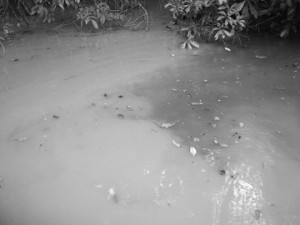 Also, some miners, when asked, related that when utilizing mercury, a leaf was used to cover the vapour arising from the heating of the amalgam instead of the required retort. The use of mercury is addressed in the mining regulations and they prohibit the use of it during the primary stages of mining operations such as in sluice boxes, hammer mills and ball mills; the discharge of amalgamation tailings into water bodies and the burning of amalgam in open air. Mercury is toxic and once released, accumulates in the food chain and its improper use has been a major concern in relation to mining.
Also, some miners, when asked, related that when utilizing mercury, a leaf was used to cover the vapour arising from the heating of the amalgam instead of the required retort. The use of mercury is addressed in the mining regulations and they prohibit the use of it during the primary stages of mining operations such as in sluice boxes, hammer mills and ball mills; the discharge of amalgamation tailings into water bodies and the burning of amalgam in open air. Mercury is toxic and once released, accumulates in the food chain and its improper use has been a major concern in relation to mining.
Regarding the tailings dam breaches, miners told this newspaper that it had been this way since the day before and it was observed that nothing was being done to repair the breakage. At this point, the water of the creek was clear but further downstream the colour changed. The creek empties into the Essequibo River and at the mouth the differences in the colour of the two bodies of water is stark, with the yellowish water of the Omai Creek contrasting with the brown water of the Essequibo.
Yellow-coloured sediment was deposited on the leaves of submerged plants and a seine that was placed close to the mouth of the river, apparently to catch fish was pointed out.
Water with a NTU (turbidity units) of 30, which would be barely cloudy to the eye is the standard required for discharge into waterways under the regulations. While miners are required to take and keep records of the turbidity level, those who spoke with this newspaper said that this is not done by them. They pointed out however, that mines officials when they come around do conduct tests.
Backdam committeeSimona Broomes is a medium-scale mining operator and the Chairperson of the Omai Backdam Committee, which has a membership of 35 persons who mine in the area. A miner for 15 years, she said that she had set up operations at the spot after a relative secured a block at Quartz Hill. But after the opening of the area to mining last year, hordes of illegal miners, descended on this area and committed many breaches of mining rules, resulting in massive pollution and with the threat of closure and of being placed before the courts, the organization, which initially had a larger membership, was formed. Broomes said that after reaching a deal with the GGMC, members were allowed to remain on 12-months contracts and the regulations were enforced. She said that operations are vastly different from what obtained before the agreement was reached.
But questioned about the breaches, which are in the locale of committee members’ operations, the miner committee chairman said that enforcement was the responsibility of the mines commission and the committee could only report to the officers when infringements occurred. Broomes was in the city, when she spoke to this newspaper and said that she was unaware of the tailings dam breaches.
Asked why no action had been taken, she said that the there could be varying reasons for this. “That is not the responsibility of the mining committee, the onus is on the mines officers to ensure that mining is carried out based on the rules and regulations given out by the GGMC”, she declared.
Woolford differed. He said that when such incidents happened, sometimes miners did not “own up” to anything. He said that miners have to understand that they are responsible. “They have got to be self-regulatory, they have a responsibility to be self-regulatory”, he said and asked “should it be that they will only do the right thing when the police come to lock them up?”
Broomes stated that the officers should be there every day and such occurrences are what they have to look out for and those incidents would not be allowed if they were present. “They are supposed to see and take action against it”, she said adding that the GGMC should check with the officials in the area. “There are cases where persons breach and the committee recommend that the person be expelled but this is not done” she said.
The GGMC commissioner conceded that officers were supposed to be in the area every day. He said that every fortnight, the muddiness of rivers is checked and noted that at times, mining officials would be on the ground at odd hours like 3 am.
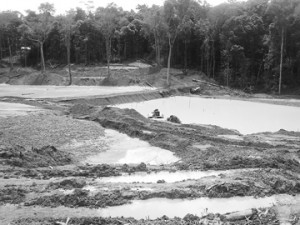 When it was further pointed out to Broomes that the tailings dam breaches had occurred within operations that belonged to members of the committee, she said that something should have been done to rectify this with immediate effect and persons should have come together and effected repairs. “If you were a miner and your tailings pond has a breach, then you have to act, you shouldn’t have to wait on a mines officer”, she said adding that if it was big, they would have be advised by the GGMC about what can be done.
When it was further pointed out to Broomes that the tailings dam breaches had occurred within operations that belonged to members of the committee, she said that something should have been done to rectify this with immediate effect and persons should have come together and effected repairs. “If you were a miner and your tailings pond has a breach, then you have to act, you shouldn’t have to wait on a mines officer”, she said adding that if it was big, they would have be advised by the GGMC about what can be done.
Opining that over 90% of the miners were complying with the mining regulations Broomes declared that many of them had learnt of the requirements on their own and asserted that the GGMC did not inform them of their obligations though a booklet was given to them, when the contracts were signed. Asked about contingency/response plans as stipulated in the regulations and which would outline the response in the event of tailing dam failures, chemical spills and other possible eventualities, and whether the GGMC required this, Broomes said “we have not had such dialogue”.
All operators in large and medium scale mining would have been required to submit such plans to the commissioner within two years of the commencement of the regulation while small-scale miners are required to submit a clean-up plan for each proposed site of operation in the event of a spill. Woolford said that the commission was pushing for full compliance and assessments have been conducted in the area. He declared that the GGMC had held education and awareness programmes but attendance was an issue. “Too many of the miners do not show up for the training programmes”, he said.
The commissioner noted that the majority of the miners in the area had been complying with the regulations and problems encountered were mainly environmental in nature. He said that one was when the miner left, the tailings pond had to be properly decommissioned and this is a problem but the commission was working with miners. He said that in some areas, miners were not in sufficient compliance because of peculiar situations such as clay taking a long time to settle.
 Meantime, other miners in that area that this newspaper spoke with declined to state their names. One man, who described himself as a small-scale miner was critical of the mining regulations, which, he said had been put in place by the GGMC. He stated that after they had been given twelve-month contracts to mine in the area, they were told that they could not put their tailings in the creek, had to utilize a tailings pond, had to use a flocculent and when they are finished, the pits had to be covered.
Meantime, other miners in that area that this newspaper spoke with declined to state their names. One man, who described himself as a small-scale miner was critical of the mining regulations, which, he said had been put in place by the GGMC. He stated that after they had been given twelve-month contracts to mine in the area, they were told that they could not put their tailings in the creek, had to utilize a tailings pond, had to use a flocculent and when they are finished, the pits had to be covered.
So is he obeying the rules? “If you can’t obey the rules, you can’t wuk”.
But when the breaches were pointed out to him, he said that excavators could not get to the area and so it was just left there and it was up to the GGMC to do what they could. Stabroek News was told that the dams had broken away some months back but with recent rains, it had been washed away further.
In the area, too a group of miners washed gravel in their battels at a discoloured pond, seeking gold.
Stating that they were small scale miners, those that spoke with this newspaper seemed quite knowledgeable about the regulations and about the effects of mercury. But when one was asked about a retort, he did not know what it was. He said that whenever they used mercury, a green leaf was placed over the steam resulting from the heating of it. He said that the vapour also escaped. This newspaper also noticed during the ride into the camp that one bare-chested man held a mixture of what appeared to be gravel and soil in a battel over a fire, in an open area. The mixture was steaming and while it was not clear whether, he was using mercury; the man was not using any protective equipment.
With regards the use of the mercury, Hinds had said that it is expected that all miners would conform to the regulations governing this and noted that he has required every member of the GGMC to enforce these regulations proactively and vigorously. “We have had a number of years of education and encouragement to use mercury safely without endangering one’s self and others, now is the time for enforcement”, he declared. Woolford told Stabroek News that use of the green leaf is not good enough.
On the issue of restoration of mined lands, Hinds had said while this area is still new to the small and medium scale mining sector, this should be learned and cited the Jamaican experience with regards to this issue in their bauxite industry.
He revealed that an estimated 0.5%, amounting to 175,000 acres of Guyana’s forested lands, is evidently disturbed by small and medium scale mining and much of this is concentrated in about a dozen locations in swathes up to about 20,000 acres. “We must see that the inevitable disturbance as we mine an area must be for as short a period as possible”, he declared noting that there is much that the GGMC and medium-scale gold mining sector can and must learn from Jamaica’s experience in restoring and reclaiming their bauxite pits.
The Prime Minister added that the GGMC has been stretched to keep abreast of the surge in the number of active mining units and while there are many areas for improvement, there is much to commend in the regulatory body.
Meanwhile, Woolford, reiterating that it was a small subset of the entire mining industry said that if out of 700 operations only 40 are not adhering to the regulations “then perhaps we are not doing as badly as people think”. He added that the commission is still not satisfied with this number. “We don’t want this to become characteristic, we want to see the mining industry as an honourable industry, making our contribution to Guyana”, he said.
